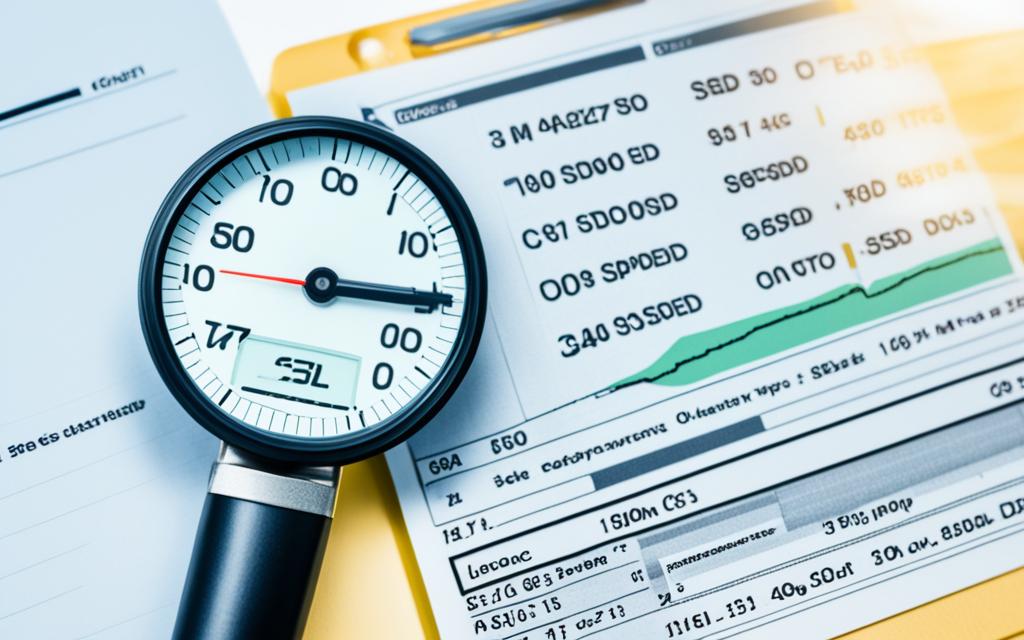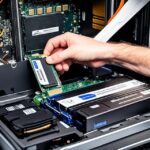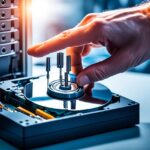Table of Contents
In today’s world, a slow solid-state drive (SSD) can be a real headache. Especially when you need quick access to your files. Users often face SSD speed issues, like the Samsung SSD writing slowly. These problems might arise from several reasons. Factors like not enough RAM, wrong computer settings, and old firmware can slow down your SSD1. Also, if your SSD is completely full, it’ll likely perform poorly. This can be made worse by viruses1. Our goal is to help you understand how to speed up your SSD. By learning various optimization Tips, you can boost your SSD’s performance1.
Key Takeaways
- Identify common SSD performance issues that may arise.
- Understand the impact of low disk space on SSD speed.
- Ensure you are using the latest firmware and BIOS for your SSD.
- Explore the significance of enabling features like TRIM and AHCI.
- Perform regular maintenance to prevent performance degradation.
- Investigate potential hardware issues affecting SSD functionality.
- Implement strategies for effective SSD management and optimisation.
Understanding SSD Technology
Solid-State Drives (SSDs) have changed the way we store data. They use integrated circuits for quicker access and efficiency. An SSD definition shows it doesn’t have moving parts. This is why they’re much faster than traditional Hard Disk Drives (HDDs).
What is an SSD?
An SSD stores data using flash memory, which makes it very fast. It doesn’t have moving parts, making it reliable and durable. When comparing SSDs with HDDs, SSDs are clearly better for those needing speed and performance.
Advantages of Using SSDs Over HDDs
The solid-state drive benefits are many. Some important ones are:
- Improved Performance: SSDs start up and load applications much faster.
- Durability: They are less likely to break from shocks since they have no moving parts.
- Energy Efficiency: They use less power, so battery life lasts longer in laptops and other devices.
- Noise Reduction: SSDs don’t make noise, unlike HDDs that can be quite loud.
It’s key to not fill an SSD too much; keeping 20% free space is good for stable performance2. When SSDs get too full, their performance might drop3. People prefer SSDs for their speed and the benefits they offer in both personal and work computers.
Common Causes of Slow SSD Performance
It’s key to know why an SSD might be running slow to keep it working well. Slow SSDs often come from two main issues: not enough disk space and old firmware or drivers. Fixing these can make your SSD faster.
Low Disk Space
The effect of running out of space on an SSD is huge. With little space left, the SSD slows down a lot. This means it might take longer to start up your computer. For example, it could take about two minutes to boot, even longer than an old HDD like the WD Blue 7200.
To keep things running smoothly, watch how full your disk is. Managing your data on time helps avoid slowdowns.
Outdated Firmware and Drivers
Old firmware and drivers can slow down your SSD too. About half the time, these issues cause the slowdown. Storage controllers or chipsets often need updates4.
Manufacturers like Samsung or Kingston recommend regular updates. This helps your SSD work its best. Keeping everything current avoids problems with other computer parts. This can be important for about 30% of slowdowns4.
So, making update checks a habit can keep your SSD running fast and reliably. It stops slowdowns caused by old software.
Why is my SSD so slow?
Many things can slow down your SSD, making it not work as fast as you’d like. It’s very important to know how bad disk health and wear over time can affect it. This knowledge helps keep your SSD running well.
The Impact of Poor Disk Health
Poor disk health greatly slows down your SSD. Wear and tear over time make it prone to issues like file fragmentation. These issues can make your SSD slower. It’s best to keep free space above 20% for good performance. If more than 75% of the SSD is used, it might run slower5. Check your SSD’s health often. Tools like CrystalDiskInfo are great for keeping an eye on its condition. They help you spot problems before they get worse.
Performance Degradation Over Time
Over time, every SSD slows down a bit. Not using the latest firmware, not having enough RAM, and skipping regular upkeep can cause this. The TRIM command fixes it by telling the SSD which data blocks it can delete. This keeps things moving fast6. Update your SSD’s firmware and keep your system well-adjusted to avoid slowdowns. Regularly performing tasks like disk write caching makes a big difference5
How to Test Your SSD Speed
Checking your SSD speed is crucial for keeping it running smoothly. You can use Windows tools and third-party apps for this. These methods help you know if your SSD is fast or if it has problems.
Using Built-In Windows Tools
Windows has tools like Performance Monitor to check SSD speeds. You can also use Resource Monitor to see how the disk performs under different tasks.
Third-Party Applications for SSD Speed Tests
For more detail, try software like CrystalDiskMark. It’s easy to use for measuring disk speeds on Windows. For Mac users, Novabench is good to test read and write speeds, mainly on Intel systems.
Premium SSDs can reach speeds over 1000MB/s. Ordinary ones usually are between 300 to 600MB/s78. ATTO Disk Benchmark is another good software. It works with many types of hardware. Remember, the SSD’s performance also depends on connecting it to the right port8.
Checking System Configurations
Having the right system settings is key to boosting SSD speed. The role of AHCI mode importance is crucial. It lets the SSD talk better with the computer system, making data move faster.
Enabling AHCI Mode
To fully use your SSD’s abilities, you need to switch on AHCI mode in the BIOS. Not doing so can limit your SATA controller. This leads to slow data access and even the blue screen of death. Also, turning off Onboard VGA can make your computer start faster. It shows the need to set your BIOS boot order properly. Doing this could cut down boot times by as much as 15 seconds9.
Ensuring Correct Boot Order
It’s vital to make sure the SSD is the first option in the boot sequence. If your computer tries to start with an HDD first, it will take longer to boot up. It also slows down finding files. Setting the SSD as a top priority speeds up your computer significantly9.
Also, keeping your SSD from getting too full is very important. Aim to have at least 20% of its space free5.
Regular BIOS and firmware updates ensure your system stays compatible and swift. Missing updates or not activating options like AHCI and TRIM affects performance. It’s also vital to check that cables and ports are okay, as they impact speed too9.
Correct system configurations for SSD lay the foundation for better speed. They make your computer operate smoothly and quickly.
For tips on making your SSD run faster, visit this link.
Potential Hardware Issues
Dealing with SSD hardware issues can greatly boost your system’s speed. To find out why it’s slow, inspect the SATA cable carefully. Also, check the other main parts. Bad SATA ports or loose cables can slow down the SSD. This affects how quickly data moves and how fast your system starts.
Inspecting SATA Ports and Cables
It’s crucial to keep SATA ports and cables in top shape for your SSD to work well. Regular checks should look for damaged cables. They should also ensure connections are tight. A bad cable can lead to unpredictable failures, making things slower. It can cause more system crashes too. Always choose cables from trusted makers to avoid problems from cheap hardware.
Verifying RAM and Other Components
Having enough RAM is key for good system speed, as it greatly affects SSD performance. Not enough RAM can slow down the SSD. Make sure your RAM works well and fits your needs. If your system runs out of RAM, it might use the SSD for extra space. This will slow it down. To avoid this, keep an eye on the health of both RAM and SSD. Setting up checks for their condition can stop issues before they start. Regular maintenance lets you spot future hardware problems early. This keeps your computer running smoothly and efficiently.
Strategies to Improve SSD Performance
To boost your SSD’s speed and efficiency, you need good strategies. Turning on the TRIM command is key. It tells your SSD which blocks it can stop using, making it run better over time5. Without TRIM, SSDs slow down because they get filled with data no one needs anymore5.
Enabling and Running TRIM Command
Keeping the TRIM command on not only makes your SSD last longer but also keeps it running fast3. You can turn it on in the system settings or with a command prompt. This helps your SSD use space better. Checking often to make sure it’s still on is good for your SSD.
Free Up Space and Manage File Clutter
It’s important to keep your SSD tidy to make it run better. Try to keep 20% of its space empty to avoid slowing it down5. Use tools like MiniTool System Booster to get rid of junk and things you don’t need3. A cleaner disk works faster and lasts longer.
Doing regular clean-ups boosts speed and makes your computer work better. Removing background tasks that use too much RAM can fix slow read and write speedsCheck here to learn more10.
Conclusion
Optimising your SSD is key for smooth computer use. Knowing what slows down your SSD is vital for better performance. It’s smart to keep 15-20% of your SSD’s space free11. Updating firmware and enabling TRIM support are crucial steps for keeping your SSD fast and durable11.
Turning off unnecessary visuals and choosing performance over power savings can boost your SSD. These changes are important to check on regularly.
Using the tips from this guide significantly improves how your SSD works. Heavy background tasks can slow down writing speed, so managing your system well is important11. Running speed tests often with good software helps you keep track of your SSD’s condition. Staying on top of these things boosts your SSD’s speed over time.
The improvement path for your SSD is continuous. Committing to regular upkeep and fine-tuning is key. This approach ensures your SSD works efficiently and stays reliable12.
FAQ
What are the common signs of a slow SSD?
If your SSD is slow, you might notice long boot times and sluggish app loads. Your system overall might also perform poorly. You can spot these issues by regularly checking performance.
How can I check if my SSD is performing optimally?
Checking your SSD’s health is easy with tools like Windows Performance Monitor. You can also use applications like CrystalDiskMark. These tools show how fast your SSD can read and write data.
What should I do if my SSD is near full capacity?
Remove files and apps you don’t need to make space. Disk-cleaning software helps too, by removing junk files and optimising storage.
Why is firmware important for SSD performance?
Firmware updates fix issues, boost reliability, and add features to your SSD. It’s important to regularly get updates from brands like Samsung and Kingston. This keeps your SSD fast.
What role does RAM play in SSD performance?
Enough RAM is key as it can affect your system and SSD speed. It’s crucial to have enough working RAM for your computer to run smoothly.
Can I improve my SSD’s speed through configuration changes?
Certainly, activating AHCI mode in your BIOS can speed up data transfers. Also, setting your SSD as the primary boot drive helps with faster system responses.
Q: What is the TRIM command, and how does it affect SSD performance?
The TRIM command keeps your SSD running quickly by organising free space better. It’s important to enable TRIM for keeping your SSD in top shape over time.
Q: How often should I perform maintenance checks on my SSD?
It’s a good idea to check your SSD every few months. This helps you keep an eye on disk health, clear out extra data, and update firmware. Doing this prevents slower speeds.
Source Links
- https://www.easeus.com/computer-instruction/ssd-slow-write-speed.html – How to Fix SSD Slow Write Speed on Windows 10/11 [Full Guide]
- https://datarecovery.com/rd/slow-performance-on-an-ssd-6-common-causes/ – Slow Performance on an SSD: 6 Common Causes – Datarecovery.com
- https://systembooster.minitool.com/boost-pc/ssd-running-slow.html – What If SSD Running Slow Windows 11/10? 8 Fixes to Speed up!
- https://www.fortect.com/how-to/fix-laptop-slow-after-ssd-upgrade/ – Laptop Slow After SSD Upgrade: 5 Easy Fixes
- https://www.easeus.com/computer-instruction/improve-ssd-read-and-write-speed.html – How to Improve SSD Read and Write Speed [100% Working Solutions]
- https://www.partitionwizard.com/resizepartition/do-ssd-slow-down-when-full.html – Do SSD Slow Down When Full & How to Fix It? [Answered]
- https://www.makeuseof.com/ways-test-ssd-speed-performance/ – 3 Ways to Test SSD Speed & Performance
- https://www.easeus.com/partition-master/test-ssd-read-write-speed.html – How to Test SSD Read/Write Speed on Windows 10/11 [Step-by-Step Guide]
- https://www.clonefileschecker.com/blog/how-to-fix-slow-ssd-performance-in-windows-10/ – How to Fix Slow SSD Performance in Windows 10 |
- https://www.pchardwarehelp.com/guides/optimize-ssd-windows.php – How to Optimize SSD for Faster Performance (Windows Tweaks)
- https://www.ubackup.com/articles/crucial-ssd-slow-write-speed-6007-ac.html – Unleash the Speed: Overcoming Crucial SSD Slow Write Speed
- https://forums.opensuse.org/t/ssd-is-slow-why/108481 – SSD is slow. Why?








